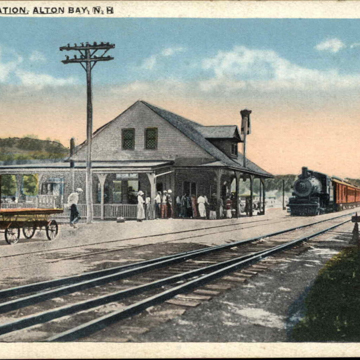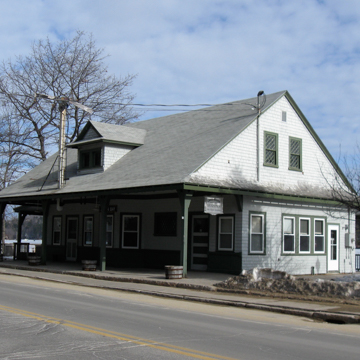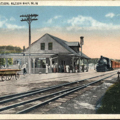You are here
Alton Bay Railroad Station
The Alton Bay Railroad Station, now used as the Alton Bay Community Center, was built in 1907 for the Boston and Maine Railroad by contractor Lewis Killam of Haverhill, Massachusetts. The third railroad station to be erected at the resort village of Alton Bay, it served its original purposes until 1935 when train service to the village was terminated. Not only did it meet railroad transport needs, but it also was a major transfer point from the railroad line to the wharf servicing the steamboats of New Hampshire’s largest lake. Only a few buildings associated with the integrated railroad-steamboat service have survived. With the exception of a lakeside, shed roof porch added sometime before 1935, this structure has retained its initial architectural integrity to the present day.
The Alton Bay Railroad Station was designed by a thus far unidentified architect and his choice of the Shingle Style should be considered unusual as it was employed primarily in residential architecture. Typical of this design vernacular are the shingled walls, the flared gable pediments with their diamond-paned, double-sash windows, and the expansive, low-pitched roof covering not only the main, rectangular building block, but also the trackside platform porch. The closed gable dormer piercing the roof plane above the porch provides additional illumination to the attic story interior. This highly functional wooden structure is the only surviving Shingle Style railroad station in New Hampshire.
Writing Credits
If SAH Archipedia has been useful to you, please consider supporting it.
SAH Archipedia tells the story of the United States through its buildings, landscapes, and cities. This freely available resource empowers the public with authoritative knowledge that deepens their understanding and appreciation of the built environment. But the Society of Architectural Historians, which created SAH Archipedia with University of Virginia Press, needs your support to maintain the high-caliber research, writing, photography, cartography, editing, design, and programming that make SAH Archipedia a trusted online resource available to all who value the history of place, heritage tourism, and learning.




